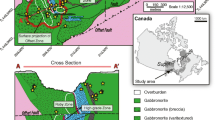Abstract.
At the Bingham Canyon porphyry copper deposit, sulfide mineralization progresses outward from a low-grade core through the following general zones: (1) molybdenite, (2) chalcopyrite–bornite, (3) chalcopyrite–pyrite, (4) pyrite, and (5) sphalerite–galena. The low-grade core and the molybdenite zone are composed of net neutralizing rock and will generally not acidify when exposed to surface weathering conditions. The copper-bearing zones of the orebody and the surrounding pyrite halo are net acid-generating and so will tend to acidify when exposed. Rocks in the lead–zinc halo are typically net neutralizing. In plan view, the distribution of net neutralization potential (NNP) is doughnut-shaped, with a positive (net neutralizing) 1,000-m-diameter core surrounded by a negative (net acid-generating) 3,000-m-diameter ring. Rock exposed in the lower 100 m of the current pit has a positive NNP and is overlain by 500 m of rock with a negative NNP.
Similar content being viewed by others
Author information
Authors and Affiliations
Additional information
Electronic Publication
Rights and permissions
About this article
Cite this article
Borden, R.K. Environmental geochemistry of the Bingham Canyon porphyry copper deposit, Utah. Env Geol 43, 752–758 (2003). https://doi.org/10.1007/s00254-002-0698-5
Received:
Accepted:
Issue Date:
DOI: https://doi.org/10.1007/s00254-002-0698-5




